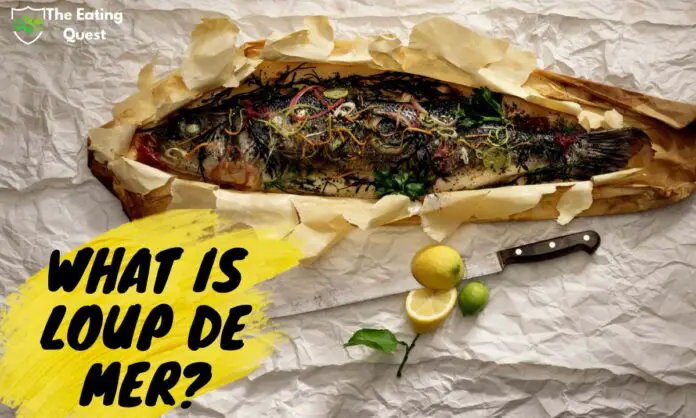If you’re a seafood lover, you might have heard of loup de mer, also known as European sea bass or Branzino. This fish is popular in the Mediterranean region and has been a staple in many European cuisines for centuries. In recent years, loup de mer has gained popularity in the United States and can be found in many high-end restaurants.
Loup de mer is a versatile fish that can be cooked in many ways, including grilling, baking, or pan-searing. It has a mild, delicate flavor that pairs well with many ingredients, such as lemon, garlic, and fresh herbs. If you’re looking for a healthy and flavorful seafood option, loup de mer is a great choice.
Key Takeaways
- Loup de mer is a popular fish in Mediterranean cuisine and has gained popularity in the United States in recent years.
- This fish has a mild, delicate flavor that can be cooked in many ways and pairs well with many ingredients.
- Loup de mer is a healthy and flavorful seafood option.
Loup de Mer: An Overview
Loup de Mer, also known as European sea bass, is a popular fish found in the Mediterranean Sea and the Atlantic Ocean. This fish is highly valued for its delicate flavor and firm, white flesh, making it a favorite among chefs and seafood lovers alike.
The scientific name for Loup de Mer is Dicentrarchus labrax, and it belongs to the Moronidae family. This species can grow up to 1 meter in length and weigh up to 12 kg. It has a silver-gray body with a blue-green back and a white belly.
Loup de Mer is a carnivorous fish, feeding on small fish, crustaceans, and cephalopods. It is also a popular game fish, making it a favorite among recreational anglers.
In terms of nutrition, Loup de Mer is a good source of protein, omega-3 fatty acids, and vitamins B6 and B12. It is also low in calories and fat, making it a healthy choice for those watching their diet.
Loup de Mer is commonly prepared in a variety of ways, including grilling, baking, and frying. It pairs well with a variety of flavors, including lemon, garlic, and herbs such as thyme and rosemary.
Overall, Loup de Mer is a delicious and nutritious fish that is enjoyed by many. Its delicate flavor and firm texture make it a versatile ingredient that can be prepared in a variety of ways, making it a great addition to any seafood lover’s diet.
What does Loup de Mer fish taste like?
Loup de Mer, also known as European sea bass, is a popular fish in Mediterranean cuisine. This fish has a delicate and mild flavor, making it a favorite among seafood lovers.
The taste of Loup de Mer is often described as sweet, buttery, and slightly nutty. Its meat is tender and flaky, with a firm texture that is not too chewy. The fish has a subtle aroma that is not overpowering, but rather pleasant and inviting.
The flavor of Loup de Mer is influenced by the fish’s diet and the waters it inhabits. Fish that are caught in the wild tend to have a more complex flavor profile than those raised in farms. Wild-caught Loup de Mer has a stronger, more distinctive taste, while farm-raised fish have a milder flavor.
When cooked, Loup de Mer retains its delicate flavor and texture. It can be grilled, baked, or sautéed with a variety of seasonings and herbs. The fish pairs well with citrus, garlic, and olive oil, as well as other Mediterranean ingredients such as tomatoes, olives, and capers.
Overall, Loup de Mer is a delicious and versatile fish that is perfect for a wide range of recipes. Its mild flavor and tender texture make it a favorite among seafood lovers, and its versatility in the kitchen makes it a popular choice for chefs and home cooks alike.
Loup de Mer Cultural Influence
Loup de Mer, also known as European Sea Bass, has been a popular fish in the Mediterranean region for centuries. Due to its delicious taste and nutritional value, it has become an important part of the cultural cuisine in many countries.
In Greece, Loup de Mer is known as “Lavraki” and is a staple in many traditional dishes. It is often served grilled with lemon and olive oil, or baked with herbs and vegetables. In Italy, it is called “Branzino” and is also a popular choice for grilled or baked dishes.
Loup de Mer has also made its way into modern cuisine, with chefs around the world incorporating it into their menus. It has become a popular choice in high-end restaurants due to its delicate flavor and versatility in cooking.
In addition to its culinary influence, Loup de Mer has also played a role in art and literature. The fish has been mentioned in ancient Greek texts, and has been depicted in paintings by famous artists such as Salvador Dali.
Overall, Loup de Mer’s cultural influence can be seen in its widespread use in traditional Mediterranean cuisine, as well as its popularity in modern cooking and art.
How do you eat loup de mer?
Loup de mer, also known as European sea bass, is a delicious fish that can be prepared in a variety of ways. Here are some tips on how to eat loup de mer.
Cooking Techniques
Grilling
Grilling is a popular way to cook loup de mer. Preheat your grill to medium-high heat and lightly oil the grates. Season the fish with salt and pepper and place it on the grill. Cook for about 5-6 minutes per side, or until the fish is cooked through and flakes easily with a fork.
Baking
Baking is another great way to cook loup de mer. Preheat your oven to 375°F. Season the fish with salt and pepper and place it in a baking dish. Add a few slices of lemon and a drizzle of olive oil. Bake for 15-20 minutes, or until the fish is cooked through.
Pan-Seared
Pan-searing loup de mer is a quick and easy way to cook it. Heat a tablespoon of olive oil in a pan over medium-high heat. Season the fish with salt and pepper and place it in the pan. Cook for about 3-4 minutes per side, or until the fish is golden brown and cooked through.
Raw
Loup de mer can also be eaten raw, as sashimi or ceviche. When eating raw fish, it’s important to make sure it’s fresh and of high quality. Cut the fish into thin slices and serve with soy sauce, wasabi, and pickled ginger.
No matter how you choose to cook loup de mer, it’s important to handle it with care and respect its delicate flavor. Enjoy!
Loup de mer Nutritional Value
Loup de mer, also known as European sea bass, is a highly nutritious fish that is rich in protein, vitamins, and minerals. It is a popular choice for seafood lovers due to its delicate, mild flavor and tender texture.
Protein Content
Loup de mer is an excellent source of high-quality protein, which is essential for building and repairing tissues in your body. A 3.5-ounce serving of loup de mer contains approximately 20 grams of protein, making it an ideal food for athletes, bodybuilders, and anyone looking to increase their protein intake.
Vitamins and Minerals
Loup de mer is also a good source of several essential vitamins and minerals, including:
- Vitamin B12: important for red blood cell formation and nerve function
- Vitamin D: important for bone health and immune function
- Selenium: a powerful antioxidant that helps protect your cells from damage
- Potassium: important for maintaining healthy blood pressure levels
- Phosphorus: important for bone health and energy production
Omega-3 Fatty Acids
Loup de mer is a rich source of omega-3 fatty acids, which are essential fats that your body needs but cannot produce on its own. Omega-3s are important for brain function, heart health, and reducing inflammation in your body. A 3.5-ounce serving of loup de mer contains approximately 1 gram of omega-3s.
Is Loup de Mer a White Fish?
Loup de mer is a white fish, meaning that its flesh is light-colored and mild in flavor. However, it is not the same as other white fish such as cod, haddock, or halibut. Loup de mer has a more delicate flavor and a tender, flaky texture that sets it apart from other white fish.
In summary, loup de mer is a highly nutritious fish that is rich in protein, vitamins, and minerals. It is a great choice for anyone looking to increase their protein intake or add more omega-3s to their diet.
Is Branzino the same as loup de mer?
If you are a seafood lover, you might have heard of Branzino and loup de mer. These two fish are often used interchangeably in recipes and menus, but are they really the same fish?
Branzino and loup de mer are both names used to describe the same fish species, scientifically known as Dicentrarchus labrax. This fish is a member of the sea bass family and is native to the Mediterranean Sea and the Atlantic Ocean.
In Italy, the fish is commonly referred to as Branzino, while in France it is called loup de mer. In other parts of the world, it may be known as European sea bass or simply sea bass.
Despite the different names, Branzino and loup de mer are the same fish species and have similar characteristics. They have a firm, white flesh and a mild, delicate flavor that pairs well with a variety of seasonings and sauces. They are also a good source of protein, omega-3 fatty acids, and other essential nutrients.
When shopping for Branzino or loup de mer, look for fish that are fresh and have clear eyes, firm flesh, and a mild ocean scent. You can prepare them in a variety of ways, including grilling, roasting, or pan-searing.
In conclusion, Branzino and loup de mer are the same fish species, known for their firm, white flesh and delicate flavor. Whether you call it Branzino or loup de mer, this fish is a delicious and nutritious addition to any seafood dish.

What is the difference between sea bass and branzino?
Sea bass and branzino are two commonly used names for the same type of fish, also known as loup de mer. However, there are some subtle differences between the two.
Appearance
Sea bass and branzino have a similar appearance, with silver skin and a streamlined shape. However, branzino tends to be slightly smaller than sea bass, with an average weight of 1-2 pounds compared to sea bass, which can weigh up to 7 pounds.
Taste
Both sea bass and branzino have a mild, delicate flavor that is often described as sweet and buttery. However, some people believe that branzino has a slightly sweeter taste than sea bass.
Price
Branzino is often more expensive than sea bass, due to its smaller size and more limited availability. However, the price of both fish can vary depending on factors such as location, season, and demand.
Cooking
Sea bass and branzino can be cooked in a variety of ways, including grilling, roasting, and pan-frying. Both fish are versatile and can be paired with a range of flavors and seasonings.
In summary, while sea bass and branzino are two names for the same type of fish, there are some subtle differences in appearance, taste, and price. Ultimately, the choice between the two will depend on personal preference and availability.
Loup de Mer in Popular Culture
Loup de Mer, also known as European Sea Bass, has been a popular fish in the culinary world for centuries. It has been featured in many popular dishes across various cultures, making it a staple in many kitchens around the world.
In Greek mythology, Loup de Mer was considered a sacred fish and was associated with the god of the sea, Poseidon. It was believed that the fish had the power to grant wishes, and its scales were used in love potions.
In French cuisine, Loup de Mer is a popular ingredient in many classic dishes such as bouillabaisse and ratatouille. It is also commonly served grilled or roasted with herbs and lemon.
In Italy, Loup de Mer is known as branzino and is often served whole with a side of vegetables. It is also a popular ingredient in pasta dishes, such as linguine with clams and branzino.
In recent years, Loup de Mer has gained popularity in the United States, particularly in upscale restaurants. Its delicate flavor and firm texture make it a versatile ingredient in many dishes.
Overall, Loup de Mer has played a significant role in popular culture, both in mythology and cuisine. Its popularity continues to grow as more people discover its unique flavor and versatility in the kitchen.
Frequently Asked Questions
What is the difference between Loup de Mer and Sea Bass?
Loup de Mer and Sea Bass are two different types of fish. Loup de Mer, also known as European Seabass, is a saltwater fish that is found in the Mediterranean Sea and the Atlantic Ocean. Sea Bass, on the other hand, is a common name for various species of fish, including the Chilean Sea Bass, Black Sea Bass, and Striped Bass, among others.
What is the price range for Loup de Mer in restaurants?
The price range for Loup de Mer in restaurants can vary depending on the location and the restaurant. On average, you can expect to pay around $30 to $50 for a Loup de Mer dish in a restaurant.
How do you pronounce Loup de Mer correctly?
Loup de Mer is pronounced as “loo duh mehr” in French. In English, it is pronounced as “loop duh mehr”.
What is Loup de Mer in Greek?
Loup de Mer is known as “Lavraki” in Greek.
What is the French name for Loup de Mer?
The French name for Loup de Mer is also “Loup de Mer”.
What are some popular ways to prepare Loup de Mer for sushi or ceviche?
Loup de Mer is a popular fish for sushi and ceviche. Some popular ways to prepare Loup de Mer for sushi or ceviche include marinating it in citrus juices, adding fresh herbs and spices, and serving it with avocado or cucumber. Another popular way to prepare Loup de Mer for sushi is to sear it lightly and serve it with a soy sauce and ginger dipping sauce.
Also Read:
















